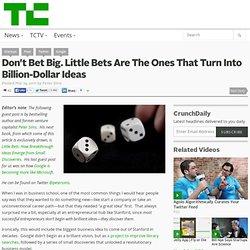

What’s The Real Deal With AngelList? Editor’s Note: This is a guest post by Mark Suster (@msuster), a 2x entrepreneur, now VC at GRP Partners.

Read more about Suster at Bothsidesofthetable There’s lots of discussion out there about a new and much-loved service called AngelList that connects entrepreneurs to angel investors. I was reluctant to write about AngelList because the debate on pros / cons is pretty nuanced. But with some heat flying I felt it worthwhile to give anybody on the sidelines a better understanding of the issues.
Bryce Roberts, a person whose opinion and judgment I greatly respect as well as a person I consider of high integrity has gone on record as having “deleted his AngelList account.” Where do I stand on AngelList? 1. I have no reason to delete my account. I’m still assuming these are all pretty high-quality intros but the top end of my funnel is already full of interesting dealflow. 2. AngelList is a great way to market your deal.
Just don’t use AngelList as a short-cut for the hard work. 3. 4. Don’t Bet Big. Little Bets Are The Ones That Turn Into Billion-Dollar Ideas. Editor’s note: The following guest post is by bestselling author and former venture capitalist Peter Sims.

His next book, from which some of this article is exclusively drawn, is Little Bets: How Breakthrough Ideas Emerge from Small Discoveries. His last guest post for us was on how Google is becoming more like Microsoft. He can be found on Twitter @petersims. When I was in business school, one of the most common things I would hear people say was that they wanted to do something new—like start a company or take an unconventional career path—but that they needed “a great idea” first. That always surprised me a bit, especially at an entrepreneurial hub like Stanford, since most successful entrepreneurs don’t begin with brilliant ideas—they discover them. Ironically, this would include the biggest business idea to come out of Stanford in decades. Larry Page and Sergey Brin didn’t begin with an ingenious idea. Of course, everyone wants to make big bets. Demystifying the VC term sheet: Dividends.
(Editor’s note: Scott Edward Walker is the founder and CEO of Walker Corporate Law Group, PLLC, a law firm specializing in the representation of entrepreneurs.

He submitted this column to VentureBeat.) In response to my last two posts demystifying VC term sheets (specifically addressing exploding term sheets and no shop provisions and price-based anti-dilution provisions), I have received a number of questions regarding other terms and provisions in term sheets.Accordingly, I thought it would be helpful to address each of the questions over the next several weeks –creating a comprehensive series of posts relating to VC term sheets. Beyond the most recent topics, I have also previously addressed valuation, liquidation preferences and stock options. Today, we’ll look at dividends and how to protect your company from over-reaching by the investors. Let’s go over some of those terms. What is a dividend? There are two types of dividends: non-cumulative and cumulative. Entrepreneur Corner: Demystifying VC jargon and the birth of Twitter.